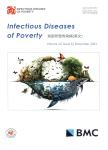Epidemiology and evolution of Middle East respiratory syndrome coronavirus, 2012-2020
Epidemiology and evolution of Middle East respiratory syndrome coronavirus, 2012-2020作者机构:Department of EpidemiologySchool of Public HealthCheeloo College of MedicineShandong University44 West Wenhua RoadJinanPeople's Republic of China State Key Laboratory of Pathogen and BiosecurityBeijing Institute of Microbiology and Epidemiology20 Dong-Da StreetFengtai DistrictBeijing 100071People's Republic of China Department of BiostatisticsCollege of Public Health and Health Professionsand Emerging Pathogens InstituteUniversity of FloridaGainesvilleFLUSA Department of EpidemiologyMinistry of Education Key Lab of Hazard Assessment and Control in Special Operational EnvironmentSchool of Public HealthAir Force Medical UniversityxranPeople's Republic of China Department of Medical ResearchKey Laboratory of Environmental Sense Organ Stress and Health of the Ministry of Environmental ProtectionPLA Stragetic Support Force Characteristic Medical CenterBeijingPeople's Republic of China Logistics College of Chinese People's Armed Police ForcesTianjinPeople's Republic of China.
出 版 物:《Infectious Diseases of Poverty》 (贫困所致传染病(英文))
年 卷 期:2021年第10卷第3期
页 面:1-13页
核心收录:
学科分类:1004[医学-公共卫生与预防医学(可授医学、理学学位)] 1002[医学-临床医学] 1001[医学-基础医学(可授医学、理学学位)] 100401[医学-流行病与卫生统计学] 10[医学]
基 金:supported by China Mega-Project on Infectious Disease Prevention(No.2017ZX10303401,2018ZX10713002,2018ZX10101003 and 2018ZX10201001) National Natural Science Foundation of China(No.81825019),and the National Institutes of Health of United States(R01 All 39761 and R01 AI116770) YY was supported by US National Institutes of Health grants R01 Al 139761 and R56 Al 148284.
主 题:Middle East respiratory syndrome MERS-CoV Case fatality rate Spatial diffusion Phylogeny Phylogeographic dynamic
摘 要:Background:The ongoing transmission of the Middle East respiratory syndrome coronavirus(MERS-CoV)in the Middle East and its expansion to other regions are raising concerns of a potential pandemic.An in-depth analysis about both population and molecular epidemiology of this pathogen is needed.Methods:MERS cases reported globally as of June 2020 were collected mainly from World Health Organization official reports,supplemented by other reliable sources.Determinants for case fatality and spatial diffusion of MERS were assessed with Logistic regressions and Cox proportional hazard models,respectively.Phylogenetic and phylogeographic analyses were performed to examine the evolution and migration history of MERS-CoV.Results:A total of 2562 confirmed MERS cases with 150 case clusters were reported with a case fatality rate of 32.7%(95%Cl:30.9-34.6%).Saudi Arabia accounted for 83.6%of the cases.Age of65 years old,underlying conditions and5 days delay in diagnosis were independent risk factors for death.However,a history of animal contact was associated with a higher risk(adjusted OR=297,95%Cl:1」0-7.98)among female cases65 years old.Diffusion of the disease was fastest from its origin in Saudi Arabia to the east,and was primarily driven by the transportation network.The most recent subclade C5.1(since 2013)was associated with non-synonymous mutations and a higher mortality rate.Phylogeographic analyses pointed to Riyadh of Saudi Arabia and Abu Dhabi of the United Arab Emirates as the hubs for both local and international spread of MERS-CoV.Conclusions:MERS-CoV remains primarily locally transmitted in the Middle East,with opportunistic exportation to other continents and a potential of causing transmission clusters of human cases.Animal contact is associated with a higher risk of death,but the association differs by age and sex.Transportation network is the leading driver for the spatial diffusion ofthe disease.These findings how this pathogen spread are helpful for targeting public health surveillance and interventions to control endemics and to prevent a potential pandemic.



